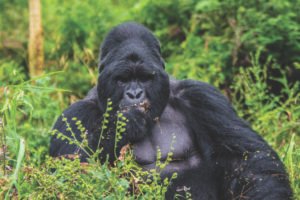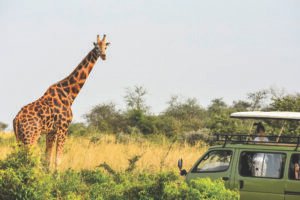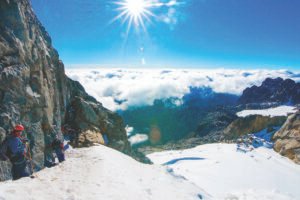
Gorilla trekking in Uganda is one of the most iconic and unforgettable wildlife experiences on the African continent. It offers a chance to see the critically endangered mountain gorillas up close in their natural forest habitat. Uganda is home to more than half of the world’s remaining mountain gorilla population, making it one of the best places on earth for this activity.
Located in southwest Uganda
Home to over 20 habituated gorilla families
UNESCO World Heritage Site
Four main trekking sectors: Buhoma, Ruhija, Rushaga, and Nkuringo
Smaller but scenic park on the slopes of the Virunga Volcanoes
One habituated family: the Nyakagezi group
Easier hikes, great views, and fewer crowds
Bonus: You can also climb volcanoes here!
Dry seasons: June–August and December–February (best hiking conditions)
Wet seasons: March–May and September–November (fewer tourists, but muddy trails)

Game drives in Uganda are one of the best ways to explore the country’s stunning savannah landscapes and encounter its rich variety of wildlife. Uganda offers classic African safari experiences — with opportunities to see lions, elephants, giraffes, leopards, buffaloes, and more, all set against breathtaking backdrops of rivers, lakes, and rolling plains.
Here’s everything you need to know:
Location: Northwest Uganda
Famous for: Huge herds of elephants, giraffes, buffalo, lions, leopards
Game drives take place mostly on the northern bank of the Nile
Combine with a boat safari to the base of the dramatic Murchison Falls
Location: Western Uganda
Famous for: Tree-climbing lions in Ishasha sector, elephants, hippos, antelope
Also offers boat cruises on the Kazinga Channel, rich in birdlife and crocodiles
Location: Remote northeastern Uganda
Famous for: Lions, cheetahs, zebras, ostriches, giraffes
Wild, untouched, and less crowded — one of Africa’s hidden gems
Location: Western Uganda (near Mbarara)
Famous for: Zebras, elands, impalas, warthogs, and leopards
Smaller but great for walking safaris and cycling safaris
Morning drives: Best time to see active wildlife (especially predators)
Afternoon drives: Good for general wildlife viewing
Night drives (in select parks like Lake Mburo): Spot nocturnal animals like leopards and bush babies
Self-drive or guided drive: Guided drives are more informative and often more successful in finding animals
Dry season (June–August & December–February): Best for wildlife visibility
During the wet season, roads can be muddy but the scenery is lush and beautiful

Mountain climbing in Uganda is a thrilling adventure that combines challenging hikes with breathtaking natural beauty and rich biodiversity. Whether you're an experienced climber or a passionate trekker, Uganda offers diverse mountain ranges — from snow-capped peaks to extinct volcanoes — each with its own unique experience.
Location: Western Uganda, along the DR Congo border
Highest Peak: Margherita Peak (5,109 meters / 16,762 ft) on Mount Stanley
Park: Rwenzori Mountains National Park (UNESCO World Heritage Site)
Highlights:
Snow and glaciers — the only place in Uganda with snow
Unique vegetation zones: giant lobelias, heathers, and moss forests
Multi-day treks (7–10 days), guided by local experts
Challenging climbs suitable for experienced hikers
Location: Eastern Uganda, on the Kenya border
Highest Peak (Uganda side): Wagagai Peak (4,321 meters / 14,177 ft)
Park: Mount Elgon National Park
Highlights:
World's largest volcanic caldera
Less strenuous than the Rwenzoris, great for intermediate climbers
Rich in wildlife, waterfalls (like Sipi Falls), and ancient caves
Treks range from 3 to 5 days
Location: Southwestern Uganda, part of the Virunga Mountains
Peaks:
Mount Sabinyo (3,645 m): hike across borders (Uganda, Rwanda, DR Congo)
Mount Gahinga (3,474 m)
Mount Muhabura (4,127 m)
Highlights:
One-day hikes with incredible panoramic views
Gorilla habitat with dense forests and volcanic landscapes
Great for beginner to intermediate hikers
Varied terrain: alpine zones, rainforests, moorlands, glaciers
Guided treks with porters and park rangers
Opportunities to spot rare plants, birds, and animals (like primates and forest elephants)
Options to combine climbing with cultural experiences and wildlife safaris
Dry seasons:
December to February
June to August
Rwenzori can be wet year-round, so good gear is a must.
 Mountain Rwenzori being the highest mountain
Mountain Rwenzori being the highest mountain